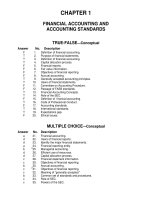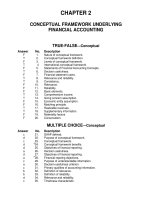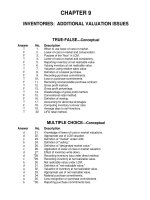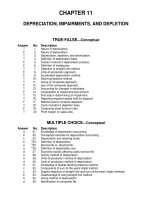Intermediate accounting 16e by kieso slide ch16
Bạn đang xem bản rút gọn của tài liệu. Xem và tải ngay bản đầy đủ của tài liệu tại đây (2.56 MB, 123 trang )
16-1
PREVIEW OF CHAPTER 16
16-2
Intermediate Accounting
16th Edition
Kieso ● Weygandt ● Warfield
16
Dilutive Securities
and Earnings per
Share
LEARNING OBJECTIVES
After studying this chapter, you should be able to:
1 Describe the accounting for
the issuance, conversion, and
retirement of convertible
securities.
2 Contrast the accounting for stock
warrants and for stock warrants
issued with other securities.
16-3
3 Describe the accounting and
reporting for stock compensation
plans.
4 Compute basic earnings per
share.
5 Compute diluted earnings per
share.
LO 1
DILUTIVE SECURITIES
Debt and Equity
Should companies report these financial instruments as a
liability or equity?
Stock Options
16-4
Convertible
Securities
Preferred Stock
LO 1
DILUTIVE SECURITIES
Accounting for Convertible Debt
Convertible bonds can be changed into other corporate
securities during some specified period of time after
issuance.
Benefit of a Bond (guaranteed interest and principal)
+
Privilege of Exchanging it for Stock
(at the holder’s option)
16-5
LO 1
Accounting for Convertible Debt
Two main reasons corporations issue
convertibles:
To raise equity capital without giving up more
ownership control than necessary.
Obtain debt financing at cheaper rates.
The accounting for convertible debt involves reporting
issues at the time of (1) issuance, (2) conversion, and (3)
retirement.
16-6
LO 1
Accounting for Convertible Debt
At Time of Issuance
Recording convertible bonds follows the method used to
record straight debt issues, with any discount or premium
amortized over the term of the debt.
16-7
LO 1
Accounting for Convertible Debt
Illustration: Miller Corporation issued $4,000,000 par value, 7%
convertible bonds at 99 for cash. If the bonds had not included
the conversion feature, they would have sold for 95. Record the
entry at date of issuance.
Issue Price = ($4,000,000 x 99% = $3,960,000)
Cash
3,960,000
Discount on Bonds Payable
Bonds Payable
16-8
40,000
4,000,000
LO 1
Accounting for Convertible Debt
At Time of Conversion
Companies use the book value method when converting
bonds.
When the debtholder converts the debt to equity, the issuing
company recognizes no gain or loss upon conversion.
16-9
LO 1
Accounting for Convertible Debt
Illustration: Moore Corporation has outstanding 2,000, $1,000
bonds, each convertible into 50 shares of $10 par value common
stock. The bonds are converted on December 31, 2017, when the
unamortized discount is $30,000 and the market price of the stock
is $21 per share. Prepare the entry to record the conversion of the
bonds.
Bonds Payable 2,000,000
Discount on Bonds Payable
Common Stock (2,000 x 50 x $10)
30,000
1,000,000
Paid-in Capital in Excess of Par—Common
16-10
970,000
LO 1
Accounting for Convertible Debt
Induced Conversion
16-11
Issuer wishes to encourage prompt conversion.
Issuer offers additional consideration, called a
“sweetener.”
Sweetener is an expense of the current period.
LO 1
Accounting for Convertible Debt
Illustration: Moore Corporation has outstanding 2,000, $1,000
bonds, each convertible into 50 shares of $10 par value common
stock. Assume Moore wanted to reduce its annual interest cost
and agreed to pay the bondholders $70,000 to convert.
Bonds Payable 2,000,000
Same
Discount on Bonds Payable
Common Stock (2,000 x 50 x $10)
30,000
1,000,000
Paid-in Capital in Excess of Par—Common
970,000
Debt Conversion Expense 70,000
Cash
16-12
70,000
LO 1
Accounting for Convertible Debt
Retirement of Convertible Debt
16-13
Recognized same as retiring debt that is not
convertible.
Difference between the cash acquisition price
and carrying amount should be reported as gain
or loss in the income statement.
LO 1
DILUTIVE SECURITIES
Convertible Preferred Stock
Convertible preferred stock includes an option for the
holder to convert preferred shares into a fixed number of
common shares.
16-14
Classified as part of stockholders’ equity, unless mandatory
redemption exists.
No theoretical justification for recognizing a gain or loss
when exercised.
LO 1
Convertible Preferred Stock
Illustration: Gall Inc. issued 2,000 shares of $10 par value
common stock upon conversion of 1,000 shares of $50 par value
preferred stock. The preferred stock was originally issued at $60
per share. The common stock is trading at $26 per share at the
time of conversion. Prepare the entry to record the conversion.
Preferred Stock
50,000
Paid-in Capital in Excess of Par—Preferred
Common Stock (2,000 x $10)
10,000
20,000
Paid-in Capital in Excess of Par—Common
16-15
40,000
LO 1
WHAT DO THE NUMBERS MEAN?
HOW
LOW PRINCIPLE
CAN YOU GO?
WHAT’S
YOUR
What do Tesla Motors Inc., Twitter Inc., AOL Inc., Red Hat Inc., and Priceline
Group Inc. all have in common? They are part of the wave of U.S. companies who
have raised capital in the convertible bond market. And quite a wave it is. As
indicated in the chart below, U.S. companies recently issued over $40 billion of
convertible bonds.
These bonds are popular
with issuing companies and
investors. As
we
have
discussed, companies like
them because they allow
them to raise money at rates
lower than those on ordinary
bonds. Investors like them
because, at a time of low
interest rates, they can book
extra profit if the issuer’s
stock price rises. However,
16-16
(continued)
LO 1
WHAT DO THE NUMBERS MEAN?
HOW
LOW PRINCIPLE
CAN YOU GO?
WHAT’S
YOUR
depending on the features of the bond and the stock value, some unusual results
may be observed. Consider the convertible bonds issued by STMicroelectronics
(STM). STM’s 10-year bonds have a zero coupon and are convertible into STM
common stock at an exercise price of $33.43. When issued, the bonds sold at an
effective yield of minus 0.05 percent. That’s right—a negative yield. How could this
happen? When STM issued the bonds, investors thought the options to convert
were so valuable that they were willing to take zero interest payments and invest an
amount in excess of the maturity value of the bonds. In essence, the investors are
paying interest to STM, and STM records interest revenue. Why would investors do
this? If the stock price rises, as many thought it would for STM and many tech
companies at this time, these bond investors could convert and get a big gain in the
stock. Investors did get some additional protection in the deal: They can redeem the
$1,000 bonds after three years and receive $975 (and after five and seven years,
for lower amounts) if it looks like the bonds will never convert. In the end, STM has
issued bonds with a significant equity component. And because the entire bond
issue is classified as debt, STM records negative interest expense.
Sources: STM Financial Reports. See also Floyd Norris, “Legal but Absurd: They Borrow a Billion and Report a Profit,” The New York
Times (August 8, 2003), p. C1; and M. Cherney, “Convertible Bonds Take Off in Low-Yield Era,” Wall Street Journal (October 5, 2014).
16-17
LO 1
16
Dilutive Securities
and Earnings per
Share
LEARNING OBJECTIVES
After studying this chapter, you should be able to:
1 Describe the accounting for the
issuance, conversion, and
retirement of convertible
securities.
2 Contrast the accounting for
stock warrants and for stock
warrants issued with other
securities.
16-18
3 Describe the accounting and
reporting for stock compensation
plans.
4 Compute basic earnings per
share.
5 Compute diluted earnings per
share.
LO 2
STOCK WARRANTS
Warrants are certificates entitling the holder to acquire shares
of stock at a certain price within a stated period.
Normally arises under three situations:
1. To make the security more attractive.
2. Existing stockholders have a preemptive right to purchase
common stock first.
3. To executives and employees as a form of
compensation.
16-19
LO 2
STOCK WARRANTS
Stock Warrants Issued with Other Securities
Basically long-term options to buy common stock at a fixed price.
Generally life of warrants is five years, occasionally ten years.
Proceeds allocated between the two securities.
Allocation based on fair market values.
Two methods of allocation:
(1) proportional method
(2) incremental method
16-20
LO 2
STOCK WARRANTS
Proportional Method
Determine:
1. value of the bonds without the warrants, and
2. value of the warrants.
The proportional method allocates the proceeds
using the proportion of the two amounts, based on fair
values.
16-21
LO 2
Proportional Method
Illustration: Margolf Corp. issued 2,000, $1,000 bonds at 101. Each
bond was issued with one detachable stock warrant. After issuance,
the bonds were selling in the market at 98, and the warrants had a
market value of $40. Use the proportional method to record the
issuance of the bonds and warrants.
16-22
LO 2
Proportional Method
Cash
2,020,000
Discount on Bonds Payable 59,216
Bonds Payable
2,000,000
Paid-in Capital – Stock Warrants
16-23
79,216
LO 2
Proportional Method
Illustration: Assume each warrant can be exercised to buy one share
of common stock ($5 par value) of Margolf Inc. for $30 per share. If
investors exercise all 2,000 warrants (one warrant per one share of
stock), Margolf Inc. makes the following entry.
Cash (2,000 x $30) 60,000
Paid-in Capital – Stock Warrants
79,216
Common Stock (2,000 x $5)
10,000
Paid-in Capital in Excess of Par—Common Stock
16-24
129,216
LO 2
STOCK WARRANTS
Incremental Method
Where a company cannot determine the fair value of
either the warrants or the bonds.
16-25
Use the security for which fair value can
determined.
Allocate the remainder of the purchase price to the
security for which it does not know fair value.
LO 2









